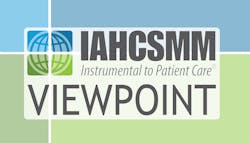Investing in educators & focused SP training promote patient safety, better outcomes
People are Sterile Processing (SP) leaders’ number one asset. Without the right people, it is impossible to run a department effectively; however, it takes more than warm bodies to keep the department running smoothly and, above all, safely. Effective leaders must be knowledgeable of current evidence-based practices to effectively assess their staff members’ abilities. Leaders must ask themselves: Do all employees function at a high enough level to mitigate errors and consistently deliver top-quality instruments and services to meet their customers’ needs? Far too often, leaders find the answer to that question is not a resounding “Yes.”
Staffing levels and other essential resources are often strained in many healthcare facilities, which impedes the department’s ability to meet the needs of its customers at critical times. Minimizing errors is a key component to customer satisfaction and successful patient outcomes, but many Sterile Processing departments (SPDs) today lack a full team of well-trained staff members who can perform any and all aspects of the job well (and across all shifts).
The power of dedicated educators
The experience, comprehension and skill sets of SP professionals can be critical differentiators in the delivery of quality healthcare. Unfortunately, many healthcare facilities still fail to invest in developing their SP staff. Whatever training these professionals do receive is often from the person or people available on the shift they have been assigned. Those assigned to orient new staff may lack formal training as an educator and they may not have received training to validate they have the necessary knowledge and skills to serve as an effective preceptor. Over time, the information transferred from one employee to the next can become less objective and key steps and processes may not necessarily be covered or even understood.
Employees who learn on the job from existing staff members as opposed to a dedicated educator may pick up departmental processes and habits that may not be associated with best practices. Additionally, the lack of a dedicated orientation program limits new employees’ understanding about the science behind their job responsibilities. Production pressures, the complexity of instruments and the unique design of today’s instrumentation and devices used in invasive procedures make it all the more imperative that SP professionals understand the science and theory behind what they do, so they are better equipped to make critical, appropriate decisions throughout the day.
To avoid diluting the science and avoid task-oriented work, healthcare systems should strongly consider incorporating a full-time educator into their budget to work alongside the SP leadership team. An effective educator can help the SP team master skills more quickly and help them better understand the science behind sterilization. Understanding the “why” makes all the difference in quality outcomes. The cost of this full-time-equivalent (FTE) can be offset by reducing orientation time for new employees and helping prevent instrument tray errors and poor service-related behaviors. In addition, an educator can develop internal policies and procedures that are easily accessible, provide clear explanations, and include photos and checklists that explain the processes in easy-to-understand, step-by-step instructions for all tasks in which the SPD is responsible.
Evaluate to ensure program delivers value
A thorough evaluation of SP professionals’ capabilities is an important component when establishing a targeted education program. Knowing employees’ capabilities and grouping staff members with similar skill levels will help establish a state-of-the-art, evidence-based education program that is most efficient and cost effective.
Initial education is only the first step. Once a program is designed and in place, it is important to reevaluate frequently and make adjustments, as needed. Organizations could consider an ongoing educational program that engages staff at all levels. Leaders should invest in their employees through a broader educational program, such as through a competency-based training program, cross training initiatives, and regularly scheduled inservicing and education days. Additional approaches to consider include train-the-trainer programs and effective use of certified tenured staff as preceptors. Encouraging and promoting advanced SP-related certification, conference attendance (local, regional and/or national) and providing memberships in professional organizations can incentivize employees in ways that improve satisfaction and retention and reduce the risk of negative outcomes.
Conclusion
Far too often, healthcare facilities fail to invest in their staff members’ education, and busy SPDs struggle to find time to adequately train and update personnel on the latest technological advances and best practices, and the high level of care needed in today’s SP discipline. It is imperative that SPDs employ an experienced educator who is actively engaged in day-to-day operations and observing every aspect of the job.
As new regulations, standards and guidelines are rolled out, it is essential that SP professionals are well trained and capable of delivering the highest level of service. Without proper training and education, hospitals and health systems are at risk of experiencing negative outcomes that will cost them money, jeopardize the organization’s reputation and, above all, place patients at risk. The SPD bears a great deal of responsibilities and hospital and health system executives need to understand that the department is just as important as the areas of the hospital it supports.
About the Author

David Taylor
Principal, Resolute Advisory Group LLC
David L. Taylor, MSN, RN, CNOR is an independent hospital and ambulatory surgery center consultant and the principal of Resolute Advisory Group LLC, in San Antonio, Texas.
